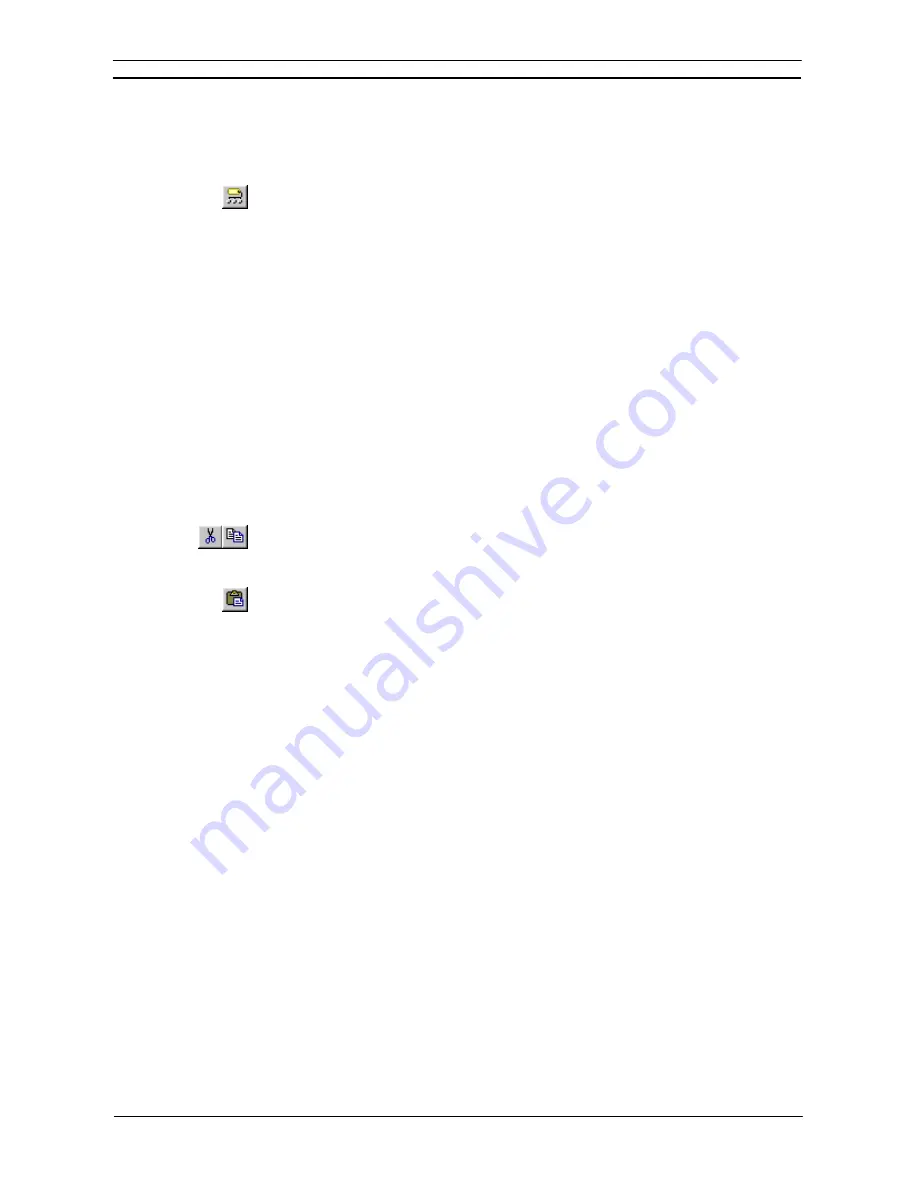
PART 1: CX-Programmer
CHAPTER 4 – Reference
OMRON
CX-Programmer _Page 54
Local Symbols
These symbols are specific to a particular program, and cannot be referenced by any other. It is recommended
that symbols are defined locally to a program unless the address is being used in multiple programs. This makes
the project more manageable and maintainable.
A program’s local symbol table is created empty. The local symbol table can be viewed by
selecting the
View Local Symbol
button from the toolbar.
It is possible to define a symbol at a local level with the same name as a symbol at global level. This is
considered an
override
of the symbol definition. The program uses the symbol definition from its local level.
This is a powerful feature, but can be achieved by mistake, so CX-Programmer issues a warning when
validating symbols if this is done.
Copying and Pasting Symbols
It is possible to cut, copy and paste symbols from one symbol table to another. It is also possible to move
symbols between tables by using drag/drop. Note that pre-set symbols can not be removed, but they may be
overridden.
For advanced users, it is possible to paste symbols from another application into a symbol table. This can be
done from any application that supports a text format – for example a spreadsheet. Refer to
Chapter 5 -
Advanced Topics
for further information.
Use the following procedure to copy or move symbols.
1, 2, 3…
1. Select a symbol, or symbols in the symbol table. More than one symbol can be selected
by pressing Shift and selecting another item to extend the selection or by pressing Ctrl and
selecting another item to add to the selection.
2. Select
the
Copy
button from the toolbar to copy the item, or the
Cut
button from the
toolbar to move the item.
3. Select a symbol table to move the items.
4. Select
the
Paste
button from the toolbar to paste the symbol or symbols. A Paste
operation can be performed several times without copying again.
Note:
If a program or part of a program (i.e. selected rungs or sections) are copied between
programs, then the symbols used within the program are copied to the new program.
Validating Symbols
The
Validate Symbols
can be selected from the context sensitive menu. When
Validate Symbol (Selected Item)
is selected, the symbol table, where the cursor is, will be checked.
Validate Symbol (ALL)
will check all the
symbol tables in the PLC, where the cursor is.
The option performs the following validation checks.
1, 2, 3…
1. The data of each symbol in the selected symbol table outputs a warning message in the
output window if any invalid symbols are found.
2. Each symbol for duplicate addresses, in the selected symbol table, and outputs a warning
message (including the symbol names) in the output window if any are found.
3. To see if any symbols, in the selected local symbol table, are overriding symbols defined
in the global symbol table and outputs a warning message in the output window if any are
found.
4. To see if any duplicated symbol names are defined in the symbol tables, and if any are
found they are output into the output window.
5. To see if any Auto-Allocated addresses have been created that do not have addresses
assigned to them and if any are found they are output into the output window as an error.
Delete Unused Symbols
Any defined symbols in the symbol tables (both Global and Local) that are not used in the program, can be
deleted by selecting
Delete Unused Symbols
from the menu. Select areas to delete symbols in the
Select area to
delete
dialog.
For symbols used in the Watch window, PLC Memory component, or Datatrace/Timechart
Monitor component, will not be counted as used symbols. Therefore, these symbols will be deleted from the
symbol tables.
Summary of Contents for Sysmac WS02-CXPC1-EV3
Page 1: ...Cat No W414 E1 01 SYSMAC...
Page 2: ......
Page 3: ...SYSMAC WS02 CXPC1 EV3 CX Programmer Ver 3 1 Operation Manual Revised November 2002...
Page 4: ......
Page 6: ......
Page 7: ...PART1 CX Programmer...
Page 8: ......
Page 24: ......
Page 34: ......
Page 106: ......
Page 130: ......
Page 131: ...PART 2 CX Server PLC Tools...
Page 132: ......
Page 136: ......
Page 158: ......
Page 168: ......
Page 194: ......
Page 206: ......
Page 250: ......
Page 298: ......
Page 304: ......
Page 305: ...PART 3 CX Server Runtime...
Page 306: ......
Page 310: ......
Page 338: ......
Page 344: ......
Page 378: ......
Page 384: ......
Page 388: ......






























